

Introducing Nanjing Confucian Temple
The Confucius Temple in Nanjing, also known as Fuzimiao, is a significant historical and cultural site. It was originally built in 1034 during the Song Dynasty as a tribute to Confucius, an esteemed philosopher and educator. The temple holds the distinction of being China’s first national highest institution of learning and is one of the country’s four major literature temples. Over the past thousand years, the temple has undergone numerous instances of damage and subsequent reconstruction. The most devastating event occurred in 1937 when Japanese aggressors set the temple ablaze, reducing it to ruins. However, in 1985, the temple was fully restored.
Over the years, the temple complex has grown to include the Jiangnan Gongyuan, the largest examination hall for candidates taking the imperial examinations during the Qing Dynasty, and Xue Gong, the Qing Imperial Academy, which was responsible for training mandarins to administer the vast empire.
The vicinity of the Nanjing Confucius Temple is characterized by a variety of tourist shops, snack bars, restaurants, and tea cafes. These establishments maintain the architectural style of the Ming and Qing dynasties, adding to the historical charm of the area.
Nanjing Confucian Temple Fast Facts
• Chinese Name: Nanjing Fu Zi Miao 南京夫子庙
• Best Time to Visit: March to November
• Recommended Visiting Hours: About 2 to 3 hours
• Things to Do: Photography, Confucianism, Chinese History and Culture
• Opening Hours: All day; 09:00-21:00 for Dacheng Palace; 09:00-21:00 for Jiangnan Examination Hall
• Entrance Fee: Free; CNY 30 for Dacheng Palace; CNY 50 Jiangnan Examination Hall
• Address: Confucian Temple Area, Qinhuai District, Nanjing, Jiangsu Province
Reasons to Visit the Nanjing Confucian Temple
Historical Significance: Originally built in 1034 during the Song Dynasty, the temple holds substantial historical and cultural value. It has been a hub for ancient Chinese culture and has the distinction of being China’s premier national institution of higher learning.
Architectural Marvel: The temple complex, encompassing the Jiangnan Gongyuan and Xue Gong, exemplifies the architectural aesthetics of the Ming and Qing dynasties. It is also home to the most extensive examination hall for imperial examinations and the Qing Imperial Academy.
What to expect at Nanjing Confucian Temple
Dacheng Hall
Dacheng Hall, also known as the Hall of Great Achievement, is the architectural centerpiece of Nanjing Confucian Temple. It spans an area of 54 by 34 meters and stands just under 32 meters high, supported by 28 intricately adorned pillars, each measuring 6 meters in height and 0.8 meters in diameter.
The hall, initially a venue for sacrificial rites, is deemed the temple’s centerpiece. Its periphery is adorned with exquisitely carved stone walls, and a copper furnace is situated at each corner. The interior of the hall houses the largest Confucius statue in China and a stunning collection of 38 vibrant panels crafted from various jade, gold, and silver, illustrating Confucius’s life. The exterior of the hall features a bronze statue of Confucius, accompanied by white marble statues of his eight disciples.
Jiangnan Gongyuan
The Jiangnan Gongyuan offers a remarkable perspective into the selection process of officials in ancient Chinese governments. The Gongyuan’s evolution commenced during the Southern Song Dynasty and continued through the Ming and Qing Dynasties, culminating in the reign of Emperor Guangxu in the Qing Dynasty. It eventually became the largest examination school in China. The primary structure of Gongyuan is the three-tiered Mingyuan Tower, encircled by 20,644 examination cells, known as ‘haoshe’ in Chinese. Presently, it houses a specialized museum dedicated to the imperial civil examination system. This museum offers an in-depth exploration of the examination system that significantly influenced the administrative framework of ancient China.
How to get to Nanjing Confucian Temple
• By Bus: Take bus 4, 7, 30, 31, 40, 44, 49, 202, or 304 to Jiankang Lu, Fuzimiao Station.
• By Sunway: Take Line 3 to Fuzimao Station.
• Charter a car/bus from GGC to enjoy a hassle-free private transfer to Nanjing Confucian Temple.
Additional travel advice on Nanjing Confucian Temple
• There are always many tourists around the Confucian Temple Area, especially on public holidays. Please take care of your belongings.
• Please take care while taking river cruise on Qinhuai River.